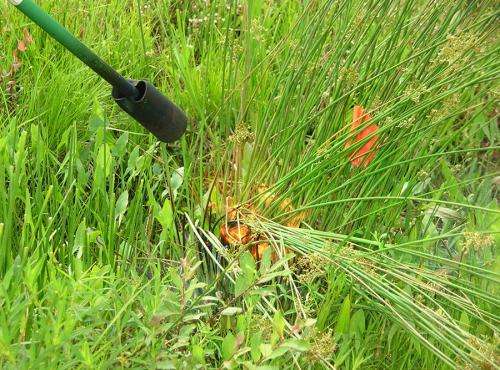Flame cultivation promising as weed control method for cranberry

Cranberries are important agricultural commodities in states such as Massachusetts, Wisconsin, New Jersey, Washington, and Oregon. But cranberry-growing operations are challenged by weeds, which compete for precious resources and often decrease fruit yields and revenues. Producers currently rely on weed management strategies such as flooding and sanding cranberry beds, hand-weeding, or applications of pre- and postemergence herbicides. Recent interest in reducing chemical inputs into cranberry growing systems has led researchers to evaluate alternative methods such as flame cultivation as a potential nonchemical weed control option.
University of Massachusetts scientists Katherine Ghantous, Hilary Sandler, Wesley Autio, and Peter Jeranyama designed a study using flame cultivation techniques for weed control in cranberry crops. The results, published in the July 2013 issue of HortScience, showed promise for integrating the weed control technique into "certain situations", including organic farming. The team tested three types of handheld propane torches (one open flame and two styles of infrared torches) and varying exposure times on several species of perennial weeds. "We thought that flame cultivation would cause damage to cranberry plants and that damage would increase with increasing exposure duration and vary by flame cultivator tool used," noted Hillary Sandler, the study's corresponding author. Surprisingly, although the results showed minor response differences between the cranberry varieties tested, all varieties showed recovery from flame cultivation (FC) damage, irrespective of which tool was used or the duration of exposure.
"Our economic analysis showed that the time and cost of using an open flame torch for spot control of weeds was similar to that of the common practice of using a wick applicator to apply glyphosate to weeds," the researchers noted. "In addition to being as cost-effective as glyphosate wipes, the non-fatal response to flame control indicates that it will cause less damage to cranberry plants that are incidentally exposed during spot treatment of weeds than glyphosate."
The experiments determined that flame cultivation could be integrated as a sustainable and economical approach for weed control in some situations. "This technology could be applicable for conventional production as well as organic production, and would ideally be used as a spot treatment for weeds growing in the cranberry canopy as well as on larger non-production areas where cranberry vines are not as abundant, such as bed edges, ditches, and dikes," the researchers concluded.
More information: hortsci.ashspublications.org/c … nt/48/7/870.abstract
Journal information: HortScience
Provided by American Society for Horticultural Science













